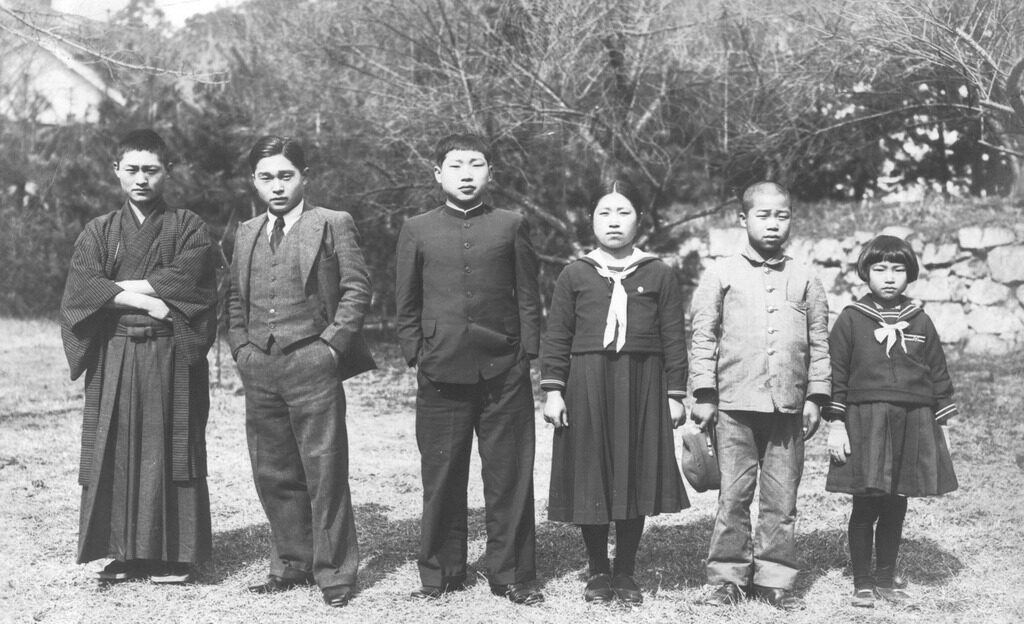June 6, 2023
A recent episode of NPR’s Code Switch explores an often forgotten chapter of Japanese American history: the Kibei story. Kibei were Japanese Americans who were born in the US to immigrant parents but spent a significant part of their early lives in Japan. Like their Nisei (second generation) contemporaries, they held US citizenship—but many Kibei were largely raised and educated in Japan, and were therefore more “Japanese” in their language and customs.
Thousands of Kibei lived in Japan before, during, and after World War II. Some returned before the war and were incarcerated in US concentration camps alongside their American families and communities, or worked as interpreters for the Military Intelligence Service. Others experienced WWII on the other side of the Pacific, living through air raids and atomic bombings by their birth country, being conscripted into service for the Japanese imperial army, or working for the American occupation following the war’s end.
As Densho Content Director Brian Niiya told Code Switch, “the general story of Japanese Americans in Japan during World War II is kind of the biggest unexplored episode in the history of Japanese Americans…. This is really a story that we need to know a little bit more about and that kind of complicates our understanding of the whole Japanese American story.”
Listen to Code Switch to hear one family’s story, then check out these resources to learn more about the Kibei experience.
Readings
Two recent books—Michael R. Jin’s Citizens, Immigrants, and the Stateless: A Japanese American Diaspora in the Pacific and A. Carly Buxton’s Unthinking Collaboration: American Nisei in Transwar Japan—offer perhaps the most extensive look at the Kibei wartime experience. Read Brian Niiya’s review here.
While not centered on the Kibei story, Brian Masaru Hayashi’s Democratizing the Enemy: The Japanese American Internment delves into the camp experience of Kibei incarcerated in the US—and how they were in some ways used as scapegoats for unrest in the camps in order to uphold the “loyalty” of other, more Americanized inmates. Jere Takahashi’s Nisei/Sansei: Shifting Japanese American Identities and Politics takes a close look at Japanese American politics before, during and after WWII through the eyes of a variety of individuals, one of whom is a Kibei.
For a firsthand account, read these memoirs:
- Memoirs of a Certain Nisei, Aru Nisei no Wadachi by Kibei war hero Thomas Taro Higa
- Beyond Loyalty: The Story of a Kibei by scholar and wartime renunciant Minoru Kiyota
- Ganbatte: Sixty-Year Struggle of a Kibei Worker by Kibei-Nisei labor organizer and communist Karl G. Yoneda
Though fictional, Naomi Hirahara’s Mas Arai novels follow one well-drawn Kibei story:
- Summer of the Big Bachi
- Gasa-Gasa Girl
- Snakeskin Shamisen
- Blood Hina
- Strawberry Yellow
- Sayonara Slam
- Hiroshima Boy
Pamela Rotner Sakamoto’s Midnight in Broad Daylight, portrays the wartime dilemmas faced by Kibei on both sides of the Pacific through the true story of Harry Fukuhara, who served with the Military Intelligence Service while three of his brothers fought for the Japanese army.
Films
Honor and Sacrifice, a 2013 documentary film by Don Sellers and Lucy Ostrander, tells the story of Kibei war hero Roy Matsumoto and his family during World War II, as told through the eyes of his daughter Karen.
From a Silk Cocoon recounts the wartime journey of Itaru and Shizuko Ina and their two young children, largely through the couple’s own words in the form of Shizuko’s diary and letters to each other when they become separated during their incarceration. Their daughter Satsuki Ina, who was born in Tule Lake and went on to become a psychotherapist specializing in community trauma and one of the founders of Tsuru for Solidarity, is a co-director of the film.
Oral Histories
[Header: Six Kibei siblings in Hiroshima, Japan c. 1936. Left to right: (in chronological order) Takeshi, Tsutomu, Noboru, Harue, Isao, and Shizue Matsumoto. Courtesy of the Matsumoto Family Collection.]
